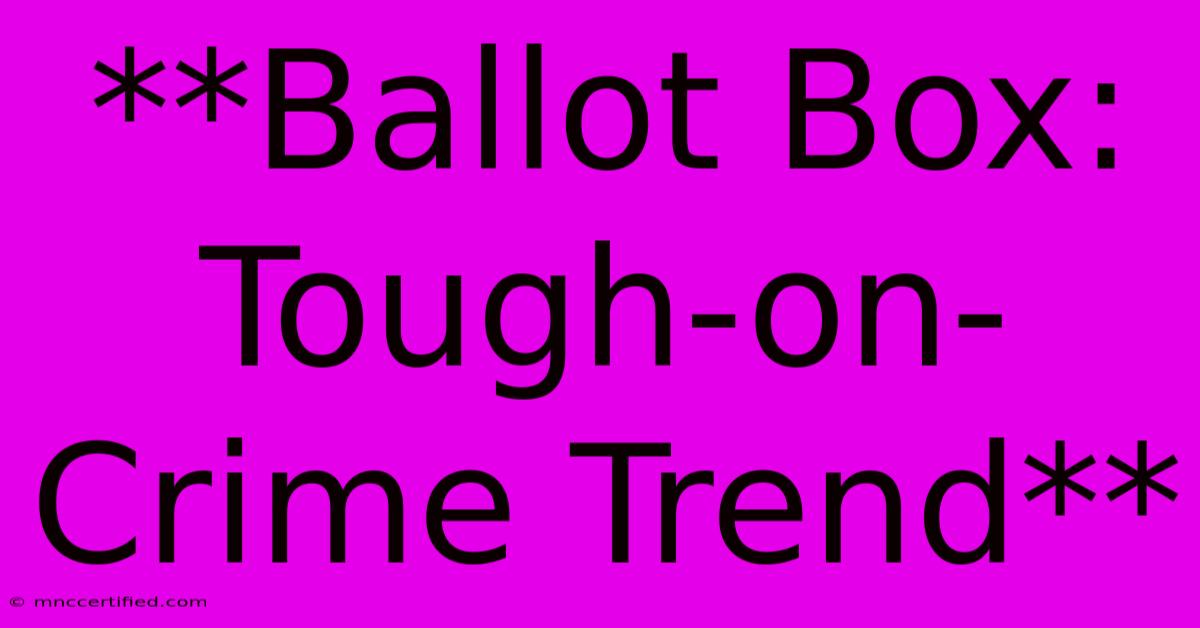**Ballot Box: Tough-on-Crime Trend**

Table of Contents
Ballot Box: Tough-on-Crime Trend Sweeps the Nation
The "tough-on-crime" approach to criminal justice has been a recurring theme in American politics, and recent trends suggest it's experiencing a resurgence. This shift is evident in the increasing popularity of candidates who promote policies that prioritize stricter law enforcement and harsher penalties for criminal offenses. This trend is driven by a complex interplay of factors, including public perception, political maneuvering, and the changing landscape of crime.
Public Perception: Fear and Frustration Fuel the Fire
The public perception of crime, often shaped by media coverage, can significantly influence policy preferences. Fear of crime, fueled by sensationalized news reports and a focus on high-profile cases, can create an environment where voters demand harsher penalties and increased police presence. This trend is particularly apparent in communities struggling with rising crime rates, where residents may feel a sense of vulnerability and demand decisive action from their elected officials.
Political Advantage: The Allure of "Law and Order"
For politicians, the "tough-on-crime" stance can be a politically advantageous strategy. Candidates who promise to crack down on crime and restore law and order often appeal to voters seeking a sense of security and stability. This approach can resonate with a wide range of demographics, from suburban residents concerned about property crime to urban communities grappling with violence.
Shifting Crime Landscape: Adapt or Be Left Behind
The evolving nature of crime also plays a role in the resurgence of "tough-on-crime" policies. As new technologies and methods of crime emerge, policymakers face pressure to adapt and implement strategies to combat these evolving threats. This often translates into a push for stricter laws, expanded police powers, and harsher punishments, reflecting a desire to stay ahead of the curve in a rapidly changing criminal landscape.
Consequences of the Tough-on-Crime Trend
While the "tough-on-crime" approach may provide a sense of immediate security, its long-term consequences are often debated. Critics argue that such policies can lead to:
- Mass Incarceration: The focus on harsher penalties has contributed to an explosion in the US prison population, disproportionately affecting minority communities.
- Increased Costs: Maintaining a large prison system is incredibly expensive, diverting resources away from other essential programs and services.
- Limited Rehabilitation: The emphasis on punishment often neglects rehabilitation programs, hindering efforts to reduce recidivism rates.
The Path Forward: Finding a Balance
The "tough-on-crime" trend raises critical questions about the future of criminal justice in the United States. While public safety remains a paramount concern, it's crucial to adopt a balanced approach that addresses both punishment and rehabilitation. This includes:
- Evidence-Based Policies: Implementing policies grounded in research and data to ensure effectiveness and minimize unintended consequences.
- Community Engagement: Encouraging community involvement in crime prevention and intervention programs to address root causes.
- Rehabilitation and Reentry: Prioritizing programs that equip individuals with the skills and support necessary to successfully reintegrate into society.
The "tough-on-crime" trend highlights the complex relationship between public perception, political maneuvering, and criminal justice policy. Navigating this landscape requires a thoughtful and nuanced approach that prioritizes both safety and justice.

Thank you for visiting our website wich cover about **Ballot Box: Tough-on-Crime Trend** . We hope the information provided has been useful to you. Feel free to contact us if you have any questions or need further assistance. See you next time and dont miss to bookmark.
Featured Posts
-
Tosh On New Di In Itvs Shetland
Nov 07, 2024
-
Governor Walz Returns Home After Election Loss
Nov 07, 2024
-
How To Make A Neutral Ground Bonding Plug
Nov 07, 2024
-
Musiala We Had To Win After Benfica Victory
Nov 07, 2024
-
Trump Takes Office Inauguration Details
Nov 07, 2024